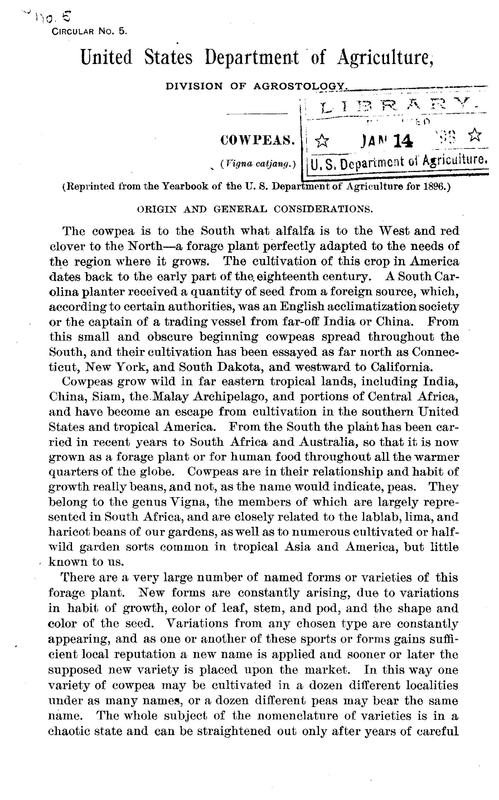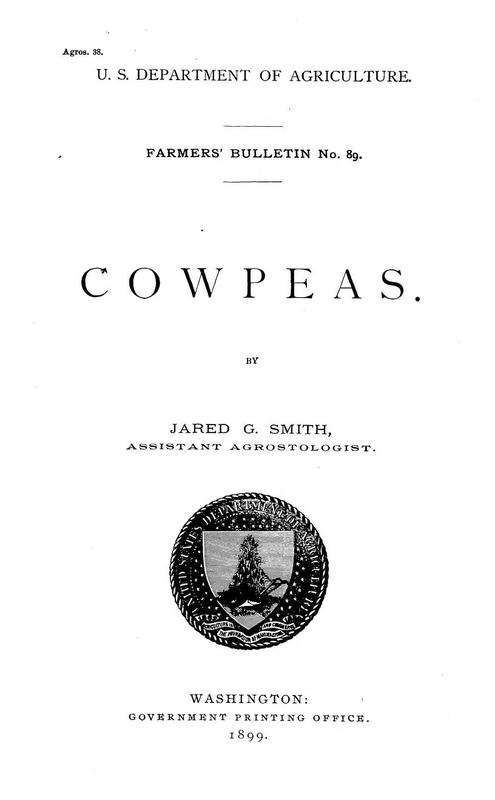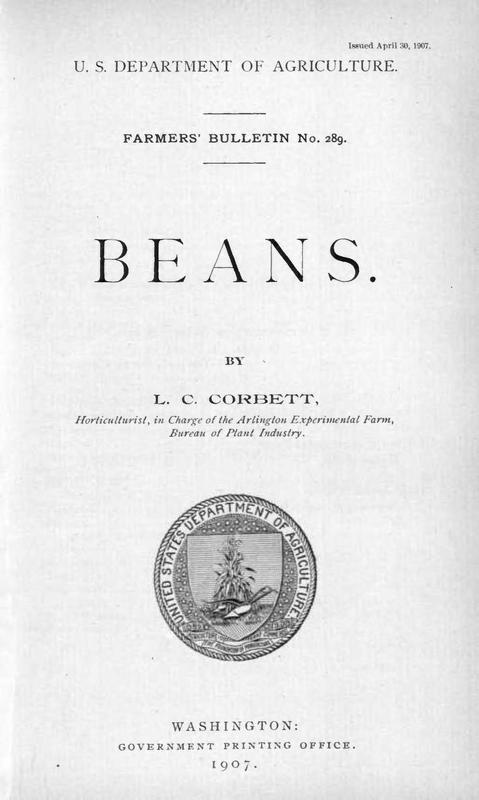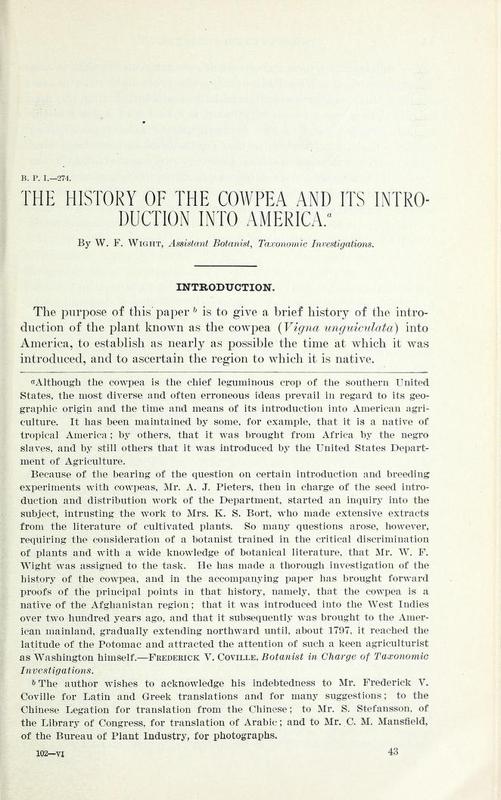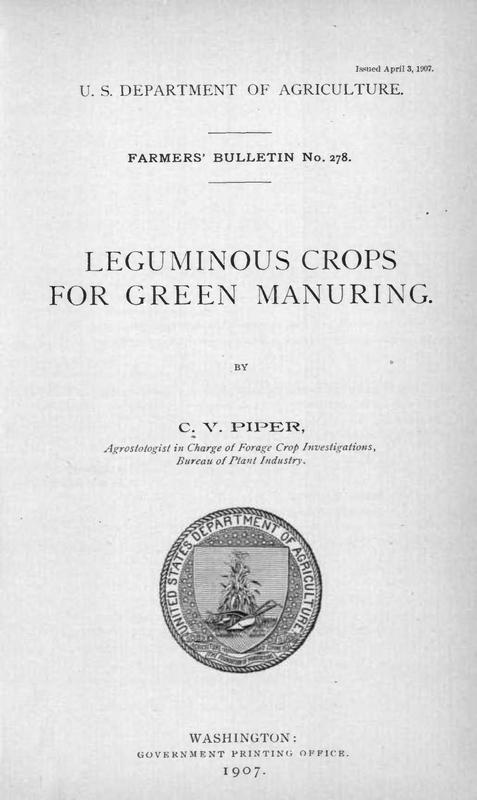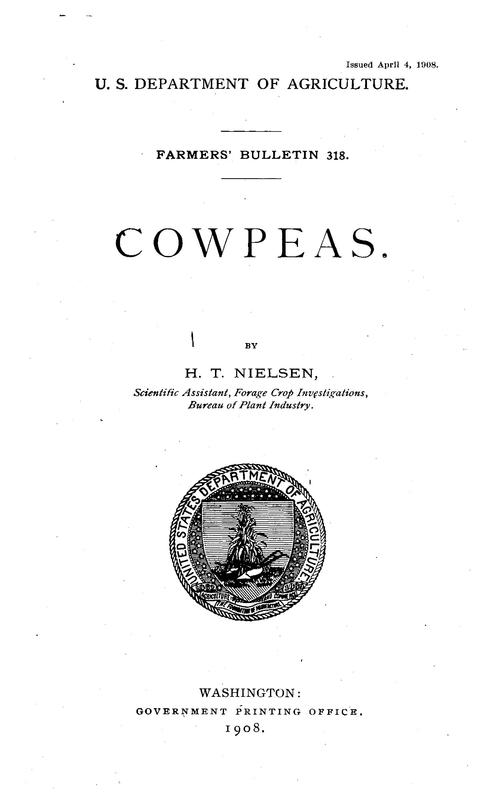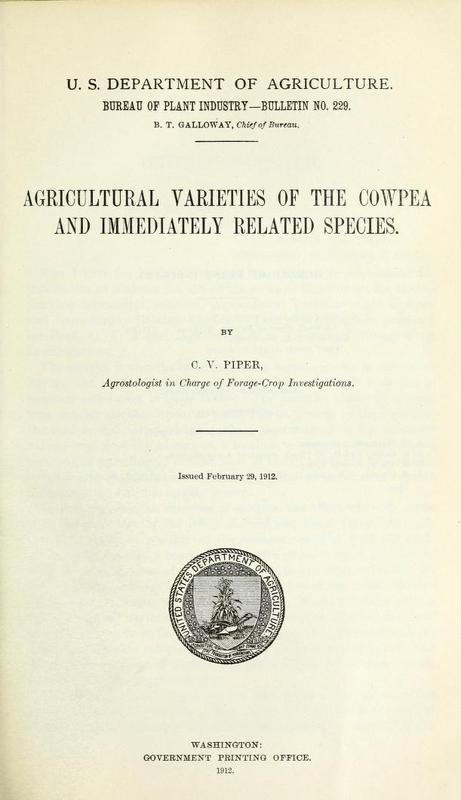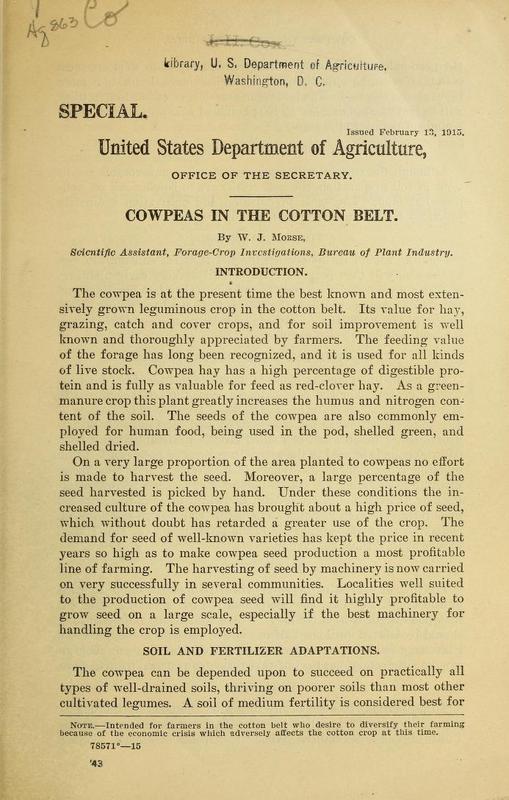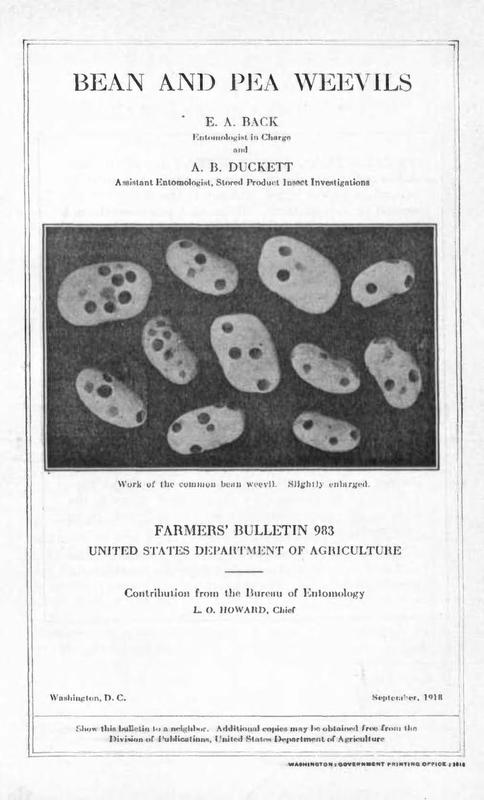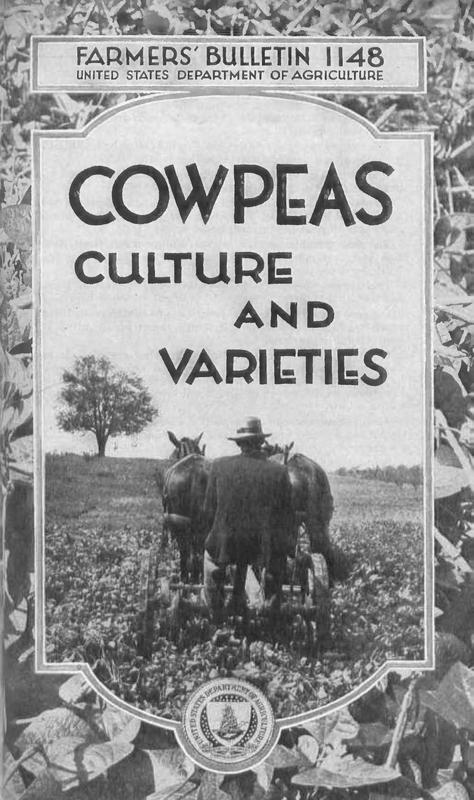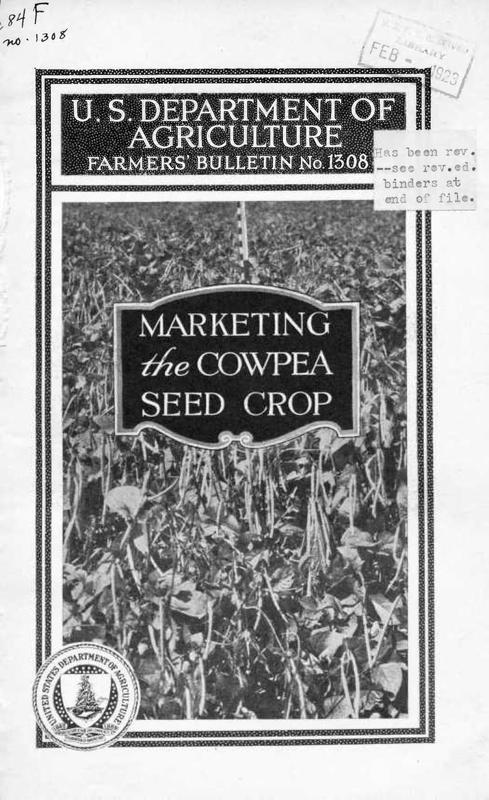USDA Historical Publications on Crop Development: Cowpeas
The U.S. Department of Agriculture created many publications that described the essential issues and requirements for different forms of crop development.
Here is a small sample of historical USDA documents that addressed issues of growing and developing cowpeas and other types of legumes for the small farmer, created around the time of Carver's bulletins.
(Click any image in this exhibit to get more information, including access to full text)
"The cowpea is to the South what alfalfa is to the West and red clover to the North — a forage plant perfectly adapted to the needs of the region where it grows. The cultivation of this crop in America dates back to the early part of the eighteenth century. A South Carolina planter received a quantity of seed from a foreign source, which, according to certain authorities, was an English acclimatization society or the captain of a trading vessel from far-off India or China. From this small and obscure beginning cowpeas spread throughout the South, and their cultivation has been essayed as far north as Connecticut, New York, and South Dakota, and westward to California.
Cowpeas grow wild in far eastern tropical lands, including India, China, Siam, the. Malay Archipelago, and portions of Central Africa, and have become an escape from cultivation in the southern United States and tropical America. From the South the plant has been carried in recent years to South Africa and Australia, so that it is now grown as a forage plant or for human food throughout all the warmer quarters of the globe. Cowpeas are in their relationship and habit of growth really beans, and not, as the name would indicate, peas. They belong to the genus Yigna, the members of which are largely represented in South Africa, and are closely related to the lablab, lima, and haricot beans of our gardens, as well as to numerous cultivated or half-wild garden sorts common in tropical Asia and America, but little known to us."
"The chief functions of this crop, then, are to furnish large amounts of nitrogen abstracted from the air and fixed in the roots and stubble in a conveniently available form for the use of succeeding crops; second, to produce a large yield of vines and peas rich in digestible protein, which, either as hay or for soiling purposes, will take the place of concentrated nitrogenous foods; and, third, to supply humus, which acts directly and indirectly to produce fertility by breaking down and rendering available the basic minerals of the soil. The fertilizing value of the nitrogen in the vines is entirely dissipated or greatly diminished by weathering when they are left on the surface of the field during the winter. Hence, to secure the full value, the cowpeas should be fed and the stable manure returned to the field. If the vines are plowed under in autumn, a winter forage crop, such as winter oats, crimson clover, rye, or vetches, should be planted to prevent the leaching and washing action of the winter rains."
"The cowpea (Vigna sinensis), because of its bean-like seed and habit of growth, its great economic importance as a forage crop for the production of hay and silage, and its great value as a green manure, should be mentioned in connection with the other plants to which it is so closely related both botanically and economically."
"The purpose of this paper is to give a brief history of the introduction of the plant known as the cowpea (Vigna unguiculata) into America, to establish as nearly as possible the time at which it was introduced, and to ascertain the region to which it is native.
Although the cowpea is the chief leguminous crop of the southern United States, the most diverse and often erroneous ideas prevail in regard to its geographic origin and the time and means of its introduction into American agriculture. It has been maintained by some, for example, that it is a native of tropical America; by others, that it was brought from Africa by the negro slaves, and by still others that it was introduced by the United States Department of Agriculture.
Because of the bearing of the question on certain introduction and breeding experiments with cowpeas, Mr. A. J. Pieters, then in charge of the seed introduction and distribution work of the Department, started an inquiry into the subject, entrusting the work to Mrs. K. S. Bort, who made extensive extracts from the literature of cultivated plants. So many questions arose, however, requiring the consideration of a botanist trained in the critical discrimination of plants and with a wide knowledge of botanical literature, that Mr. W. F. Wight was assigned to the task. He has made a thorough investigation of the history of the cowpea, and in the accompanying paper has brought forward proofs of the principal points in that history, namely, that the cowpea is a native of the Afghanistan region ; that it was introduced into the West Indies over two hundred years ago, and that it subsequently was brought to the American mainland, gradually extending northward until, about 1797, it reached the latitude of the Potomac and attracted the attention of such a keen agriculturist as Washington himself. — Feedekick V. Coville, Botanist in Charge of Taxonomic Investigations.
The conclusions which have been drawn are, briefly, that it was introduced into the West Indies during the latter half of the seventeenth century and probably reached the mainland during the first half of the eighteenth century; that it is a native of India and the region northwestward to the southern part of the trans-Caspian district; that its cultivation in that region is of ancient date; that its cultivation extended to China at a very early period ; that it was known in Arabia and Asia Minor as early as the beginning of the Christian era, and was cultivated in at least one of the countries of southern Europe at about the same time, but that its introduction into central Europe was of much later date and entirely independent of its introduction into southern Europe."
"The cowpea (fig. 5) is used more than any other crop as a soil renovator in the South. Its use is rapidly increasing, but is yet far from general. During the past few years the high price of the seed has tended to discourage more extensive growing. Recent progress in the harvesting of cowpea seed by machinery will doubtless materially reduce its cost. The seed is at present almost entirely picked by hand.
The cowpea is characterized by remarkable ability to grow in poor soils and to cover the ground so densely as to choke out most weeds. It usually bears an abundance of tubercles on its roots, whether the soil has been inoculated or not, although in new localities where the cowpea has not been previously grown the tubercles may be absent. In such cases inoculation is necessary, for it must always be remembered that it is through the tubercles on the roots that the beneficial effects of the cowpea or other legume largely depend.
Cowpeas are very common1y planted between rows of corn at the time of the last cultivation, or they are broadcasted upon the stubble of small grains. Cowpeas, however, like other crops, respond markedly to cultivation and there is a growing tendency to plant them upon well prepared soil. This practice results in a great increase of the crop, whether grown for hay or for seed. (See fig. 1, p. 5.)
More numerous experiments have been conducted in this country to determine the effects of cowpeas used as a green manure than have been devoted to all other leguminous crops combined. Almost without exception these experiments have indicated a very beneficial effect upon the succeeding crop. The benefit often lasts two or three years. These good results follow on practically all succeeding crops, whether cotton, corn, sorghum, or small grains. Except on the poorest soils careful experiments show that it is decidedly more profitable to use the cowpea crop as hay or pasture and then plow under the stubble than it is to plow under the whole crop. While plowing under the whole crop produces as a rule a greater effect, it is not enough greater to equal the value of the cowpea crop as feed."
"A system of agriculture without the use of a leguminous crop tends to lessen the productivity of the soil and makes necessary large outlays for nitrogenous fertilizers. With a leguminous crop grown at frequent intervals, the productivity may be maintained or even increased. The cowpea (fig. 1) is at the present time, and probably will continue to be, the most valuable legume for the entire cotton belt, and can be depended upon to succeed on practically all types of soils. It has been well said that the cowpea is to the South what red clover is to the North and alfalfa to the West.
It is safe to say that no one thing can add more to the agricultural wealth of the South than the more extensive growing of the cowpea. This will supply the southern markets with much of their hay, which is now shipped in from the North and West. It will tend to increase the production of live stock, which is very essential in securing the maximum returns in any system of agriculture; and it will go far toward keeping the soil in good tilth and maintaining its productiveness.
While cowpea culture has greatly increased in late years, this very fact has in part brought about a large increase in the price of seed. The more extensive use of the crop will be seriously retarded until seed becomes more plentiful than at present. Fortunately the development of improved machinery for handling cowpeas makes it certain that this will soon be the case and that the price of seed will be materially reduced without lessening the profit to the grower."
"The cowpea is now the most important legume grown in the cotton States. At the present time about 15 varieties of this crop are in common cultivation in these States. The varieties grown in a small way number perhaps twice as many more. Owing to the fact that the seed is still largely hand picked, the tendency is for whatever variety was first introduced in a locality to persist. The increased commercial handling of cowpea seed in recent years has to a considerable extent changed this condition of affairs, but varieties of relative inferiority are still too largely grown.
In investigating the varieties of cowpeas the effort has been made, with the assistance of the Office of Seed and Plant Introduction, to obtain as many as possible of the existent varieties from all parts of the world, so that a comprehensive idea of them could be obtained with the end in view of determining which are most valuable. In this collection are also included many varieties of the closely related species, the asparagus bean and the catjang. While it is very certain that the list of varieties that have been brought together for comparison and study is far from exhaustive, yet it is believed that the series is sufficiently complete to exhibit all of the characteristics which occur in this group of plants that are likely to be of value either directly or to the plant breeder.
On account of the importance of the cowpea various extensive investigations of the crop have been undertaken by this Bureau. The present bulletin presents the results obtained by a comprehensive study of the varieties, not only of those already occurring in this country, but of numerous lots from abroad obtained mainly by the Office of Seed and Plant Introduction. Largely on the basis of facts ascertained in these studies a great amount of breeding work is being conducted by Mr. George W. Oliver, with the idea of developing improved varieties by combining the best of the traits exhibited. In close connection with this work Prof. W. J. Spillman is studying the Mendelian behavior of the hereditary characters. The work of Mr. W. A. Orton in hybridizing Iron and other cowpeas to develop varieties with high yield of forage and seed, together with resistance to wilt and other diseases, is also closely allied with these investigations."
"The cowpea is at the present time the best known and most extensively grown leguminous crop in the cotton belt. Its value for hay, grazing, catch and cover crops, and for soil improvement is well known and thoroughly appreciated by farmers. The feeding value of the forage has long been recognized, and it is used for all kinds of live stock. Cowpea hay has a high percentage of digestible protein and is fully as valuable for feed as red-clover hay. As a green-manure crop this plant greatly increases the humus and nitrogen content of the soil. The seeds of the cowpea are also commonly employed for human food, being used in the pod, shelled green, and shelled dried.
On a very large proportion of the area planted to cowpeas no effort is made to harvest the seed. Moreover, a large percentage of the seed harvested is picked by hand. Under these conditions the increased culture of the cowpea has brought about a high price of seed, which without doubt has retarded a greater use of the crop. The demand for seed of well-known varieties has kept the price in recent years so high as to make cowpea seed production a most profitable line of farming. The harvesting of seed by machinery is now carried on very successfully in several communities. Localities well suited to the production of cowpea seed will find it highly profitable to grow seed on a large scale, especially if the best machinery for handling the crop is employed."
"Beans, peas, and cowpeas are often damaged seriously in storage and in the field by weevils. Velvet beans and soy beans are rarely infested in this country. Bean and pea weevils not only destroy much of the Nation's food in the form of leguminous crops hut are responsible for a curtailment in the acreage planted to these crops. They never attack corn and wheat.
There are no satisfactory artificial remedies that can he applied to kill weevil grubs in beans, peas, or cowpeas growing in the field.
The crop should he harvested as soon as possible after maturity and the seeds thrashed or shelled and treated by fumigation, heat, or cold storage, in order to kill the weevils in them before they can continue their destructive work and mature.
The bean and cowpea weevils breed generation after generation in stored seeds. Hence seeds should be watched after treatment to make certain that they do not become reinfested. If stored in tight containers or in rooms free from adult weevils the chance of reinfestation will he reduced to a minimum.
This bulletin tells about the principal kinds of bean and pen weevils and explains fully the methods of averting losses from these pests."
"The cowpea is the best known and most extensively grown leguminous crop in the Southern States. It is grown mainly for forage and to improve the soil, but the seeds are rather commonly used for human food.
The cowpea is of the greatest value in the cotton belt, although it can be grown profitably much farther north.
The cowpea will do best on sandy loams, but will succeed on practically all types of well-drained soil.
To obtain the best results with cowpeas, poor or unproductive soils should be fertilized with about 300 pounds of acid phosphate and 50 pounds of potash to the acre.
The most valuable varieties are the Whippoorwill, Groit, New Era, and Brabham for seed or hay and the Blackeye or the White for table use.
The cowpea should not be sown before corn-planting time, and usually it is better to wait until at least two weeks later.
For seed production the best practice is to sow in rows 3 feet apart, while for forage or soil improvement broadcasting is most generally practiced.
Cowpeas grown in combination with other crops, such as sorghum, Sudan grass, Johnson grass, and millet, produce a larger yield of hay, which is more easily handled and cured than cowpeas grown alone and constitutes a better balanced ration.
The cowpea succeeds under such a wide range of conditions that it can be used to good advantage in almost any system of rotation.
Root-knot and wilt, the two diseases most serious to the cowpea in the United States, may be controlled largely by growing such resistant varieties as the Iron, Brabham, and Victor and by rotating with crops not affected.
The most serious insect enemies of the cowpea are the cowpea weevil and the 4-spotted bean weevil, both of which cause considerable damage to the seed. These weevils may be easily controlled if proper methods are employed in caring for the seed.
As a summer annual the cowpea is brought more or less into competition with velvet beans and soy beans. In the regions adapted to these crops the cowpea succeeds for general purposes under a greater diversity of conditions."
"The cowpea plant may be fed to live stock as pasturage, hay, or ensilage, and the seed may be used as human food. Cowpeas are not grown for seed more generally because of the uncertainty of the crop, the expense of harvesting, and the low yield commonly obtained. These factors have created a relatively high price for the seed.
In localities well suited to production it will be found highly profitable to grow cowpea seed on a large scale, especially if the best machinery for handling the crop is used.
Harvesting cowpea seed can be done most cheaply by the use of machinery. The crop may be cut with a mower, self-rake reaper, or bean cutter. When the plants are 'thoroughly dry, the seed may be thrashed with an ordinary grain separator with modifications, or, better still, with a machine specially constructed for thrashing cowpeas.
The seed has a high feeding value, but is rarely cheap enough to use as feed. It is fed to some extent to poultry.
The cowpea is generally and favorably known in the South as a staple human food, being used in the pod, shelled green, and shelled dry.
Good cowpea seed can be stored for a considerable length of time without much danger of loss of vitality.
Cowpea hay is an excellent roughage for all kinds of stock. When cut at the right stage of growth and properly handled, the cowpea is equally as nutritious as the hay from other legumes and is greatly relished by all farm animals.
The hay is somewhat difficult to cure, but with attention to the stage of growth and to weather conditions, little more trouble will be experienced in obtaining well-cured cowpea hay than red-clover or alfalfa hay.
The cowpea alone has not given good results as a silage crop, the best silage being obtained when it is mixed with corn or sorghum.
Although pasturing cowpeas is not considered the best farm practice, under certain conditions it is advisable and quite profitable.
As a soiling crop the cowpea can be advantageously used to supplement crops with less protein, such as corn, sorghum, and millet.
The cowpea has been used more as a soil renovator than any other legume because it is so easily grown, has such a marked effect upon succeeding crops, and succeeds under such a great diversity of conditions."
"The annual farm value of cowpeas produced in the United States during recent years averages over $18,000,000. On most farms, however, the cowpea is grown largely as a catch crop, is considered of secondary importance as a money crop, and in many instances is handled in an unbusinesslike manner. This results not only in a direct monetary loss to the grower, but may mean a more serious economic loss to the farmers desiring to purchase cowpea seed.
The cowpea is of major economic importance in the crop rotation, especially in the Cotton Belt, but it is an uncertain producer of seed, and in some years there is an apparent shortage of stocks for planting purposes. Investigations show that almost invariably a lack of cowpea seed in any section may be attributed to inefficient farm preparation for market and inequitable distribution of existing stocks rather than to insufficient production. This bulletin points out some of the methods by which growers may conserve their surplus production of cowpeas, prepare them for market, and sell them in such a way as to return a greater net profit for themselves and to provide an adequate supply of good-quality stocks for farmers who find it necessary to buy."
 An official website of the United States government.
An official website of the United States government.


